What do you think of when you hear the word “backpack”? The bookbag you carried to school? The hiking backpack that’s been your trusty companion on so many adventures? There are lots of different types of backpacks, and it’s important to know the differences between them so that you can choose the right pack for your needs.
Backpack Sizing
When you’re looking for a backpack, the first thing you need to consider is size. A backpack’s carrying capacity affects its bulk and its weight. The largest backpacks that can carry the most have internal frames to provide structural support. This makes them heavier than a backpack you’d wear for everyday purposes but allows them to hold a lot of items when you’re backpacking or using the backpack as travel luggage.
How Much Can You Fit In A Backpack?
Backpack capacity is measured in liters (L), but that might not mean much when you’re figuring out how much you can pack. You usually don’t think of your gear in terms of volume! Here’s a chart that has example loads for each backpack size category.
| Backpack Size | Backpack Capacity | Best Uses | Example Load |
| Small (S) | Less than 20 L | Everyday carry, tech carry, day travel | Umbrella, small laptop, water bottle, cords and cables, tablet, keys, wallet, passport, book, sunglasses |
| Medium (M) | 20-35 L | School, work, gym, carry-on luggage | Laptop, spare set of clothes, extra pair of shoes, rolled up jacket or sweater, book, keys, wallet, cords and cables, water bottle, umbrella, snacks |
| Large (L) | 40-80 L | Hiking, backpacking, travel carry-on | 2-3 spare sets of clothes, a jacket, extra pair of shoes, toiletries, umbrella, snacks, cords and cables, larger laptop, keys, wallet, a couple of books |
| Extra Large (XL) | 80+ L | Hiking, backpacking, long trips | 3-4 spare sets of clothes, a jacket, extra shoes, toiletries, towel, umbrella, snacks, cords and cables, larger laptop, hiking gear and equipment, keys, wallet, multiple water bottles |
These are just examples of sizing and what you can fit in each size of a backpack. We have an extensive guide to backpack capacity if you would like to know more.
Backpack Types
It’s not just capacity that determines what a backpack’s best use is. Materials, design, construction, and other aspects of the backpack affect this as well! Here, we’ve broken down the different types of backpacks into their main uses.
Everyday Backpacks
These backpacks typically have one main compartment or one main compartment and a laptop compartment. Typically they’ll be fairly basic in construction; you won’t see high-performance ventilated panels or padded straps on these backpacks. They are designed to carry your everyday needs and not be particularly heavy.
Antitheft Backpack
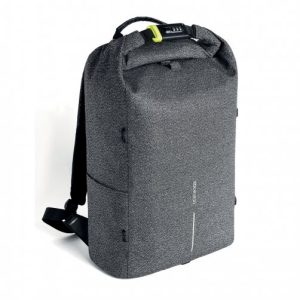 At first glance, an anti-theft backpack doesn’t look that different from any other ordinary backpack. But look again and you’ll see– or rather, you won’t see– what makes these backpacks special. Antitheft backpacks are cleverly designed to keep your stuff safe. The zipper pulls are hidden and often come with locks or belts that hold them in place. Because these backpacks are so secure, they’re ideal for travel in crowded places.
At first glance, an anti-theft backpack doesn’t look that different from any other ordinary backpack. But look again and you’ll see– or rather, you won’t see– what makes these backpacks special. Antitheft backpacks are cleverly designed to keep your stuff safe. The zipper pulls are hidden and often come with locks or belts that hold them in place. Because these backpacks are so secure, they’re ideal for travel in crowded places.
Convertible Backpack
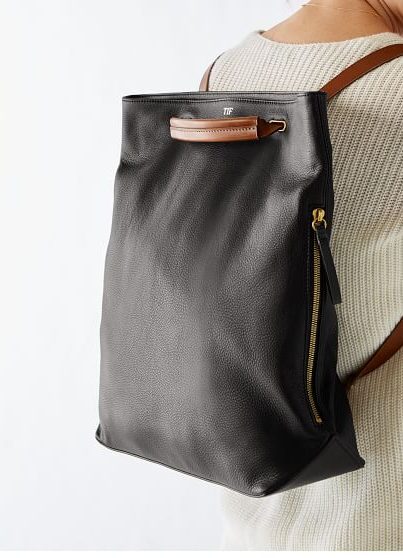 A convertible backpack is essentially a tote bag with shoulder straps. These bags are great for running errands and can be carried as either a backpack or a regular shopping bag. Their capacity is 15 to 35 L, and they often come with outside pockets and at least one pocket on the inside. These bags tend to be very lightweight and are often foldable for easy storage until you need them next.
A convertible backpack is essentially a tote bag with shoulder straps. These bags are great for running errands and can be carried as either a backpack or a regular shopping bag. Their capacity is 15 to 35 L, and they often come with outside pockets and at least one pocket on the inside. These bags tend to be very lightweight and are often foldable for easy storage until you need them next.
Daypack
A daypack is just your typical backpack design. These are usually quite simple– they might not even have a front zipper compartment or any interior organization. They range in size from 20-40 L and are often quite fashionable. They come in many different colors and materials, so it’s not hard to find one that is both comfortable and reflects your personality.
Drawstring Backpack
 These backpacks are extremely light. They might have a single zipper pocket on the front, or just be a pouch with a drawstring that acts as shoulder straps. These backpacks can hold 5-10 L, but are fairly uncomfortable as they get heavy because the drawstring cuts into your shoulders. However, they’re great for taking a pair of extra clothes to the gym or just running errands.
These backpacks are extremely light. They might have a single zipper pocket on the front, or just be a pouch with a drawstring that acts as shoulder straps. These backpacks can hold 5-10 L, but are fairly uncomfortable as they get heavy because the drawstring cuts into your shoulders. However, they’re great for taking a pair of extra clothes to the gym or just running errands.
Laptop Backpack
A laptop backpack is ideal for today’s business traveler because it has a special sleeve to hold and protect your computer. These backpacks range in size from 20-50 L, and some of that space is taken up by the laptop sleeve. Not all sleeves fit all laptops, however, so make sure that your laptop will fit in the sleeve before you buy a business backpack.
Mini Backpack
Mini backpacks are cute, fashionable, and little. They’re basically just a purse that’s worn like a backpack and can hold very little– a wallet, phone, headphones, maybe a book, but not much more. Some of them are as small as 1 L, and none of these get larger than 5 L.
Rucksack
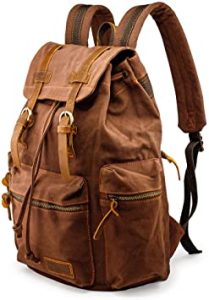 Rucksacks are daypacks that have a top flap that comes over the main compartment instead of (or sometimes in addition to) a zipper. They may have a cinch top underneath the flap or snap closed with magnets. The flap may be buckled down, snapped down, or closed using a toggle. These are usually a little bit smaller than regular daypacks, about 15 to 30 L. Military style backpacks are also often referred to as rucksacks.
Rucksacks are daypacks that have a top flap that comes over the main compartment instead of (or sometimes in addition to) a zipper. They may have a cinch top underneath the flap or snap closed with magnets. The flap may be buckled down, snapped down, or closed using a toggle. These are usually a little bit smaller than regular daypacks, about 15 to 30 L. Military style backpacks are also often referred to as rucksacks.
Sports Backpacks
Sports backpacks are designed with adventure in mind! They’re made of materials that are both rugged and lightweight and have lots of organizational features to help stow your gear.
Backpacking Backpack
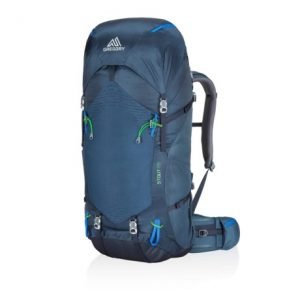 These bags are built for active travel! Backpacking backpacks are often quite large, often more than 60 L in capacity. They sometimes have internal frames that allow them to stand up when empty. These frames provide better organization and stability of the pack, which is vital on rough terrain and when carrying a heavy load. If you’re going to be packing a lot and taking long hiking trips, you might want to use a framed backpacking backpack. Backpacking packs can come in a variety of sizes, and come either with external frames (for large carrying capacity), or internal frames.
These bags are built for active travel! Backpacking backpacks are often quite large, often more than 60 L in capacity. They sometimes have internal frames that allow them to stand up when empty. These frames provide better organization and stability of the pack, which is vital on rough terrain and when carrying a heavy load. If you’re going to be packing a lot and taking long hiking trips, you might want to use a framed backpacking backpack. Backpacking packs can come in a variety of sizes, and come either with external frames (for large carrying capacity), or internal frames.
Biking Backpack
Biking backpacks are streamlined– they’re as small and lightweight as possible, around 10-30 L, because big unwieldy backpacks can slow you down. They tend to have a main compartment with a pocket for organizing tools and gear, and often have an attachment for your helmet on the front. You can usually put a hydration bladder in the main compartment as well.
Climbing Backpack
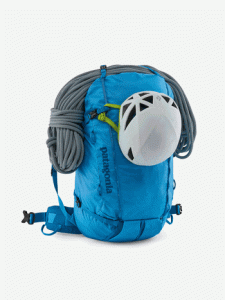 Climbing backpacks often have cinch tops and side panel zippers that make loading gear easier when you’re in an awkward position. They often come with features like rope holders and organizational pockets. They’re designed to be lightweight and streamlined to cut down on potential snags while you’re scrambling up a rock face, and are usually in the 25-50 L capacity range.
Climbing backpacks often have cinch tops and side panel zippers that make loading gear easier when you’re in an awkward position. They often come with features like rope holders and organizational pockets. They’re designed to be lightweight and streamlined to cut down on potential snags while you’re scrambling up a rock face, and are usually in the 25-50 L capacity range.
Hiking Backpack
Hiking backpacks and backpacking backpacks are often one and the same. But for shorter trips, you can often use a lightweight frameless backpack that still has a great carrying capacity. They’re a great choice for lighter loads– when you’re carrying 50 pounds of gear, you need a lot of support. But when you’re only carrying 10 pounds? You’re good without a frame. Also, many hiking backpacks are water-resistant to keep your gear dry on rainy days.
Skateboarding Backpack
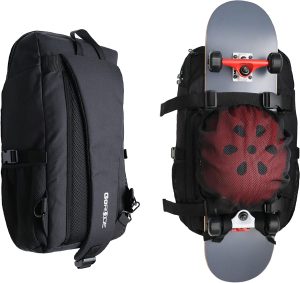 Skateboarding backpacks are often narrow, with a rectangular profile and a relatively small carrying capacity- usually around 25-30 L. That’s because these backpacks are actually meant to hold the most important gear on the outside. They have straps that let you strap your board to your back, making it easy to travel with and stow between sessions. They also have hooks or straps to clip to your helmet for easier transportation.
Skateboarding backpacks are often narrow, with a rectangular profile and a relatively small carrying capacity- usually around 25-30 L. That’s because these backpacks are actually meant to hold the most important gear on the outside. They have straps that let you strap your board to your back, making it easy to travel with and stow between sessions. They also have hooks or straps to clip to your helmet for easier transportation.
Snow Sport Backpack
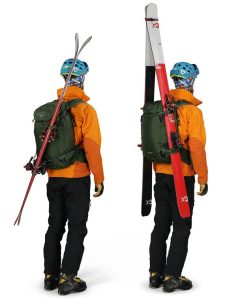 Similar to other active backpacks, snow sports backpacks have additional straps to clip on your helmet, gloves, skis, ski poles, and other gear. By stowing your snowy gear on the outside of your pack, you can keep the gear on the inside dry and safe from melted snow. These backpacks are usually in the 25-50L range but can be bigger, especially if you’re shopping for a backpack to take on a backcountry skiing overnight trip.
Similar to other active backpacks, snow sports backpacks have additional straps to clip on your helmet, gloves, skis, ski poles, and other gear. By stowing your snowy gear on the outside of your pack, you can keep the gear on the inside dry and safe from melted snow. These backpacks are usually in the 25-50L range but can be bigger, especially if you’re shopping for a backpack to take on a backcountry skiing overnight trip.
Equipment Backpacks
Some backpacks are made with specific equipment in mind. These backpacks might look like regular backpacks on the outside, but their internal organization is much different. The main compartments often can’t carry as much as you’d think because they have organizers and padding to protect sensitive gear.
Camera Backpack
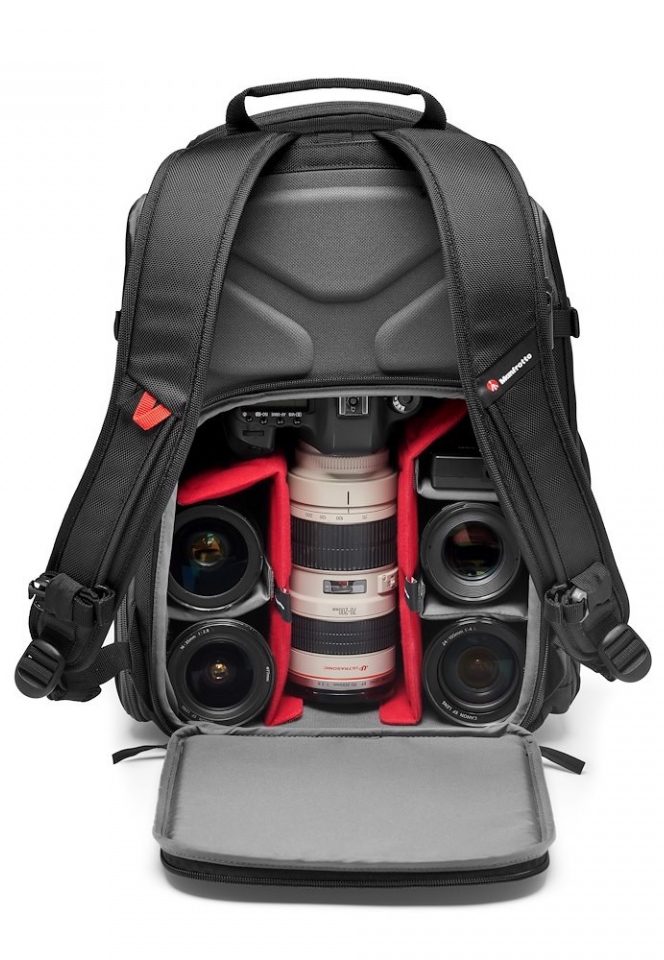 Camera backpacks are sturdy, padded, and have internal and external organizer pockets to hold expensive, fragile camera equipment. Many camera backpacks are anti-theft backpacks as well, with hidden zipper pulls. Most standard camera backpacks are 20-30 L, but some multi-camera setups can be 50-60 L. However, you can’t fit as much in them because the interior compartments are subdivided to protect lenses and camera bodies.
Camera backpacks are sturdy, padded, and have internal and external organizer pockets to hold expensive, fragile camera equipment. Many camera backpacks are anti-theft backpacks as well, with hidden zipper pulls. Most standard camera backpacks are 20-30 L, but some multi-camera setups can be 50-60 L. However, you can’t fit as much in them because the interior compartments are subdivided to protect lenses and camera bodies.
Drone Backpack
Drone backpacks, like camera backpacks, are built to hold delicate, expensive equipment. They’re padded inside and out for shock resistance and are usually waterproof or at least water-resistant. They follow the same size rules as camera backpacks– about 20-30 L or 50-60 L for multi-drone setups.
Fishing Backpack
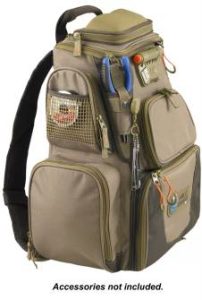 Fishing backpacks are frequently made from water-resistant materials and have lots of small organizing pockets to stash fishing lures, lines, and other fishing gear. Many of them are reinforced with extra straps and material that can take a beating. Some fishing backpacks come with rain covers and built-in tackle boxes, both of which are extremely useful. Capacity ranges on fishing backpacks vary quite a bit; you can find them in the 20-30 L range, but they can get substantially larger, into the 80+ L range.
Fishing backpacks are frequently made from water-resistant materials and have lots of small organizing pockets to stash fishing lures, lines, and other fishing gear. Many of them are reinforced with extra straps and material that can take a beating. Some fishing backpacks come with rain covers and built-in tackle boxes, both of which are extremely useful. Capacity ranges on fishing backpacks vary quite a bit; you can find them in the 20-30 L range, but they can get substantially larger, into the 80+ L range.
Hydration Backpack
Hydration backpacks are small, lightweight, and designed to hold a hydration bladder. They usually range from 3-10 L at their maximum capacity. Many of them don’t even have additional accessory pockets– they’re there for hands-free water and nothing else. Many other types of backpacks have hydration slots to place a bladder in.
Pet Backpack
Pet backpacks have mesh compartments that allow you to safely carry a pet with you. Some of these backpacks are better for short travel or taking your pet to the vet, but others are designed with hiking in mind. Unlike other backpacks, these backpacks are usually measured by weight rating– you choose the size based on the weight of your pet.
Travel Backpacks
These backpacks are designed with airport travel in mind. Backpacks make amazing carry-ons because they leave your hands free while you’re in the airport, and they’re easier to stow under a seat or in an overhead compartment because they’re soft-sided and more flexible.
Carry-on Backpack
Most backpacks can be carry-on backpacks, but to make sure your backpack can be a carry-on, it needs to be less than 22 inches tall. Their capacity ranges from 22-40 L and they usually have one or two main compartments and several pockets for good organization. Some of them have dedicated tech compartments or built-in power banks to make travel even easier.
Duffel Backpack
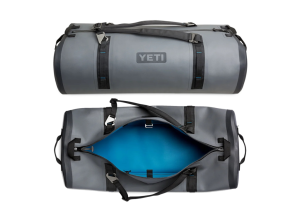 A duffel backpack is just like a duffel bag, except it has additional straps that let you wear it like a backpack. They come in a wide range of sizes, all the way from 30 L to 120 L or more. This makes them a great choice for travel and other activities where you need a lot of space. They are more comfortable to carry than regular duffel bags since the straps let you balance the weight across your back instead of it pressing down on one shoulder. However, these bags don’t have an internal structure or waist straps– so even though they can hold a lot, they’re not ideal for active travel, like hiking or backpacking.
A duffel backpack is just like a duffel bag, except it has additional straps that let you wear it like a backpack. They come in a wide range of sizes, all the way from 30 L to 120 L or more. This makes them a great choice for travel and other activities where you need a lot of space. They are more comfortable to carry than regular duffel bags since the straps let you balance the weight across your back instead of it pressing down on one shoulder. However, these bags don’t have an internal structure or waist straps– so even though they can hold a lot, they’re not ideal for active travel, like hiking or backpacking.
TSA Compliant Backpack
Similar to a carry-on backpack, these backpacks are designed to make it easy to remove your laptop when you’re going through airport security. The laptop compartment of these backpacks can be unzipped to lie flat on the scanner so that you don’t have to take out your computer at security. This makes going through the airport faster. These bags are in the 20-40 L range and are small enough to fit under the seat or in an overhead bin.
Wheeled Backpack
If you’re traveling with a backpack as your primary piece of luggage, you might enjoy a wheeled backpack. These backpacks can be either carry-on or checked luggage (some of them can be as large as 150 L), and usually have padded straps and back panels for maximum comfort. They have small wheels at the bottom and a handle that can extend out of the top of the backpack. These backpacks usually have several spacious compartments and other features for organization.
When you’re shopping for a backpack, it’s important to know what types of backpack can meet your needs. We hope this guide will help you when you’re looking for the perfect bag for your next big adventure!
Max DesMarais is the founder of hikingandfishing.com. He has a passion for the outdoors and making outdoor education and adventure more accessible. Max is a published author for various outdoor adventure, travel, and marketing websites. He is an experienced hiker, backpacker, fly fisherman, backcountry skier, trail runner, and spends his free time in the outdoors. These adventures allow him to test gear, learn new skills, and experience new places so that he can educate others. Max grew up hiking all around New Hampshire and New England. He became obsessed with the New Hampshire mountains, and the NH 48, where he guided hikes and trail runs in the White Mountains. Since moving out west, Max has continued climbed all of the Colorado 14ers, is always testing gear, learning skills, gaining experience, and building his endurance for outdoor sports. You can read more about his experience here: hikingandfishing/about
